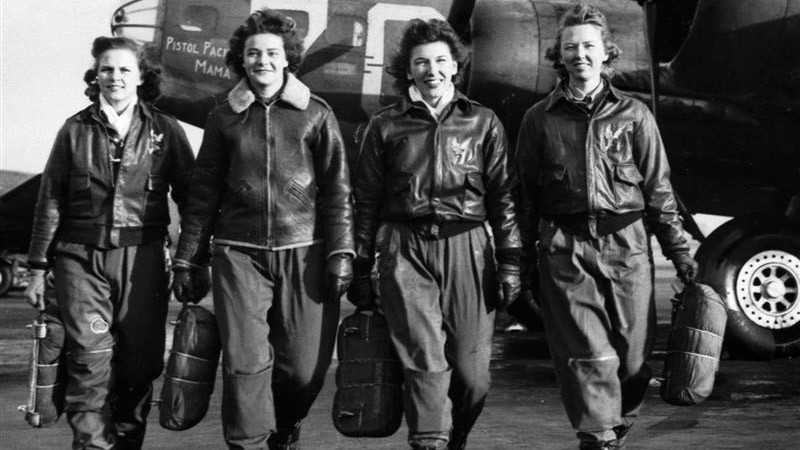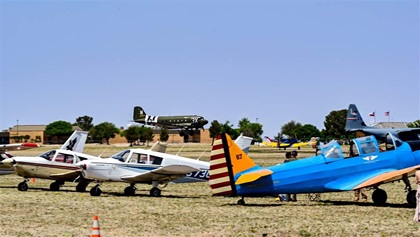Men’s war, women’s duty
A nation called; the WASP answered








You would not have to squint to picture this airport in a sepia-toned newsreel—but you would need to ignore the massive wind turbines to the west.
Here is where 1,830 women came to serve their country in an experimental program that would be the first of its kind. Here is where the Women Airforce Service Pilots (WASP) were forged. And, while their achievements were not recognized until much later in their lives—many of them would not live to see the recognition for what they had achieved—their legacy lives on as more women take to the skies in general, commercial, and military aviation.
A gamble
Reeling from the Japanese attack on Pearl Harbor and facing a shortage of pilots as the nation went to war and troops were sent overseas, U.S. leaders in 1942 gambled on an idea: train women to fly and ferry military aircraft. Pilots Nancy Harkness Love and Jacqueline Cochran founded two programs—Women’s Auxiliary Ferrying Squadron and Women’s Flying Training Detachment—that were merged to become the WASP.
More than 25,000 women applied for the program; 1,830 were accepted, and 1,074 made it all the way through. Training began in Houston and moved to Sweetwater, where the women trained under the auspices of the U.S. Army Air Forces.
Then and now
Sweetwater has served up a warm and windy April day, and visitors are tramping the dusty fields next to the runways at Avenger Field, admiring airplanes and talking to their pilots. Molly Kelly of Fredericksburg, Texas, is admiring the clean lines and classic structure of a blue-and-yellow Boeing PT Stearman Kaydet. The biplane and dozens of other vintage and not-so-vintage airplanes have flown to Avenger Field for the eightieth homecoming celebration of the WASP. The annual event draws not only surviving members of the WASP but also friends, family, and people who, like Kelly, are inspired by the women. Kelly is a pilot, and nothing as trivial as a three-and-a-half-hour drive from her hometown is going to deter her from paying respects to her heroes.
“I don’t think people understood what it took for [the WASP] to become a pilot in those days,” Kelly said. “They were the trailblazers.”

The U.S. Army would train men to become pilots, but that wasn’t the case for the WASP; they had to be certificated pilots to apply for the program. And, while women pilots were not unknown, there weren’t many. But this was an opportunity to serve their country and, for many, to get out of their little towns during an exciting time, so they did what they could to qualify. Learning about the opportunity in 1942, for example, Elizabeth Strohfus of Faribault, Minnesota, went to town, withdrew $100 from a bank account, and joined a local flying club. She “left her bicycle as collateral,” according to Minnesota Public Radio.
Out for public viewing at the homecoming are four of the five types of aircraft that the women trained in: a Boeing PT–17 Stearman, Fairchild PT–19a, and Vultee BT–13, which they flew for primary and basic training; and a Cessna UC–78 Bobcat for multiengine training. The WASP Museum at Avenger Field cares for the aircraft with the help of volunteers who keep the logbooks, manage maintenance, and fly them as needed. David Townsend, who shepherds the BT—13, says the prevailing winds at Sweetwater helped hone the women’s crosswind landing skills. “We don’t call this a windy day in Sweetwater,” he says, nodding at the flapping flag by the hangar. “This is a normal day.”
The WASP flew Beechcraft T–6 Texans for cross-country, formation, and instrument training. The museum doesn’t have a T–6 but is fundraising to acquire one to round out its collection.
The five aircraft formed a base from which the WASP would go on to fly 77 types of aircraft, including the B–26 Marauder and B–24 Liberator, and both the Lockheed P–38 and F–5. There’s a story that WASP were assigned to fly the Martin B–26 Marauder, which during its time in service had become known as a “widowmaker” and a dangerous airplane. Its short wings required landing approaches at much higher airspeeds. WASP Edna Davis became the first woman to solo the B–26. “Our job was to show it could be flown, and basically, embarrass the men,” Davis told Easy Reader & Peninsula magazine in 2016.
The WASP reportedly flew every P–47 Thunderbolt used in the war. That illustrates how the women had a direct effect on what the U.S. armed forces were doing in the European theater during the war, said Matia Karrell, director/producer of the forthcoming documentary Coming Home: The Women Airforce Service Pilots of WWII.
The WASP also towed gunnery targets—which meant soldiers on the ground shot at them, sometimes with live ammunition—transported equipment and nonflying personnel, and flight-tested aircraft. They were assigned to 110 established bases around the United States as civilians attached to the Army Air Forces.
Glimpse into the past
To wander through the National WASP WWII Museum at Avenger Field is to get a sense of the women’s lives. They bunked together, six to a bay, and their days were as hectic as today’s airline pilots undergoing indoctrination training. Mannequins model their everyday uniforms—airman suits, not tailored for petite sizes, which they had to roll up at the wrists and ankles and belt in at the waist; and shearling-collared leather jackets—and formal dress uniforms. A small brown suitcase holds civilian clothing—a dress, a hat, a purse—and some phonograph records tucked into a pocket in the lid. There are photos—women in cockpits, standing on wings, smiling during rare moments of leisure. There is a classroom with pilot’s training manuals and an E6B.
“I loved [the training],” said WASP Shirley Chase Kruse in a 2015 interview for the National WWII Museum. “We’d all flown before, and it was just a question of learning to fly that particular plane.” But not all found it so enjoyable. “You never knew when you were getting ready to go to mess hall who would [still] be in your room that night.” For every two applicants, one would wash out. “The dropout rate was pretty intense,” Kruse said. “You always left the very night you washed out, you went back to your bay, and you packed what you had, and you left. They took you to the railroad station. It was over and done with. No time for tears.”
At the rear of the museum is a bronze statue showing a WASP walking forward, looking up. She stands in front of portraits of 38 members of the group who were killed in service. The first was Cornelia Fort, who died at age 24 in 1943 in a midair collision while ferrying an aircraft from California to Texas.
Because the women were not technically part of the military, the Army did not pay to send home the bodies of the deceased. Often, their fellow WASP took up collections to pay for the final transport—sometimes accompanying their fallen comrades back home.
A quiet end
In spite of its successes and the vocal support of Gen. Henry “Hap” Arnold, the WASP program lasted just two years. The Army announced it was disbanding the group five days before Christmas 1944, and some of the women had to pay for their ticket home. Since the WASP had never been made a military unit, they did not receive military benefits. Most came home to discover there were no flying jobs, although some became flight attendants when commercial airline travel ramped up. (The first woman airline captain of a scheduled airline was Emily Warner Howell in 1973.)
That might have been the end of the story, but it’s not.
In 1976, the U.S. Air Force began accepting women in its flying program, and it reportedly said this was the first time women had been allowed to fly any of its aircraft. Not true, said the WASP. They began to lobby Congress to recognize their status as a militarized group and to gain military benefits. Congress passed the GI Bill Improvement Act of 1977, which retroactively granted WASP “active duty status” for the “purposes of laws administered by the Veterans’ Administration,” according to the U.S. Air Force. In 2009, President Obama awarded the WASP the Congressional Gold Medal for service to their country.
In 2015, however, the Department of the Army denied WASP Elaine Danforth Harmon’s final request to be buried at Arlington National Cemetery. Harmon’s granddaughter, Erin Miller, launched a successful grassroots social media and direct lobbying campaign to get the decision reversed. Miller describes the process in her book Final Fight Final Flight: My Grandmother, the WASP, and Arlington National Cemetery.
Telling stories anew
The saga of the WASP is too good to remain a footnote in the history of aviation. Books, documentaries, even a musical (called Sweetwater) that played off Broadway in 2017 have illuminated the women’s stories. Historian William M. Miller had written a book about Eugene Ely, the first pilot to take off and land on a ship. Miller was casting about for a new project when he learned about Erin Miller’s (no relation) fight to get her grandmother interred at Arlington National Ceremony. Miller’s wife urged him to take a closer look at the WASP. He subsequently wrote about the 38 WASP who died in his book, To Live and Die a WASP.
“I thought, as much as possible, it was time someone tried to tell the personal stories of these 38 women—who they were and why they flew,” he said. “I like to tell stories, especially stories about people, personal stories, and stories that most of us have never heard.”
Matia Karrell found an old photo of her mother taken on the coast of Massachusetts, and learned her mother was part of a volunteer group of airplane spotters during World War II. In trying to discover more about this group, Karrell found out about the WASP and was drawn into their history. The Red Door Films documentary Coming Home is the result.
Hilary Prentice, producer with The Red Door Films, said, “I was a history major and I didn’t know about these women, and I was pretty mad that I didn’t know about these women. Why aren’t they in any books, why are they not in TV shows?”
Karrell and Prentice said their mission is to ensure the legacy of the WASP and inspire the next generation of women to fly. While principal photography on the documentary is completed, some aerial photography remains to be shot, and the filmmakers are raising money through a nonprofit organization to pay for that. Tax-deductible donations can be made at thereddoorfilms.wedid.it/campaigns/7921.
Crown jewel
Shirley Chase Kruse, the WASP who loved training, is the sole WASP in attendance at the 2022 homecoming. The women have been honored guests at airshows, aviation conventions, and similar venues for many years, but their numbers are dwindling.
Hovering on the edge of 100 years old, Kruse is escorted carefully through the crowds by a phalanx of women in Air Force uniforms who treat her like the crown jewel she is. She stops to chat with visitors, and a smile of pure joy crosses her face when a young couple hold up their baby for her to see. That joy and love is radiated back to Kruse and all her WASP comrades by the more than 2,000 people who’ve come to Sweetwater to honor the women.
“The influence of the WASP lives on in every legacy pilot in the military and commercial aviation regardless of age, gender, or ethnicity. They are the female pilots that started building the bridge for all women,” said Lisa Taylor, executive director of the National WASP WWII Museum. The museum will continue to host a yearly homecoming celebration, and in 2023 it will be held the last weekend in April.
.



